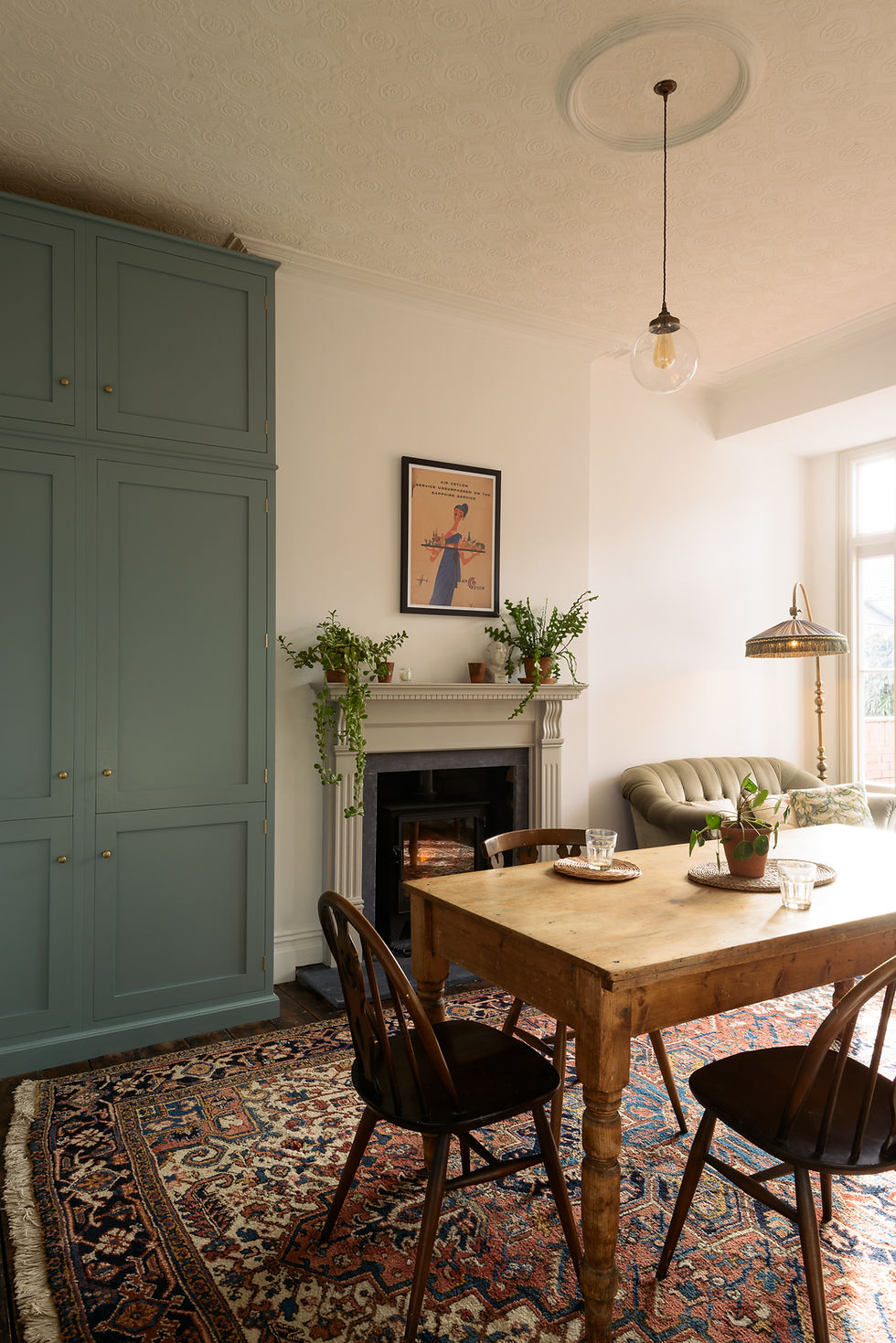Edwardian Interiors
- Louise Booyens

- Jun 4, 2021
- 8 min read
Updated: Jan 31
This period should be seen as both the Indian summer of the Victorian world and the awakening of a modern and vibrant new century.
- Trevor Yorke
This post may contain affiliate links which means I may receive a commission from purchases made through links. I only recommend books I have personally read. Learn more on my Privacy Policy page.
Growth of the Edwardian Middle Class
There were three basic Edwardian social classes - the working class, the middle class and the upper class. It wasn't easy to define the middle class as it wasn't one cohesive group but rather a hierarchy of groups between the classes above and those below.
"People in this class owned no land... your gentility was almost purely theoretical....Theoretically you knew how to wear your clothes and how to order a dinner, although in practice you could never afford to go to a decent tailor or a decent restaurant. Theoretically you knew how to shoot and ride, although in practice you had no horses to ride and not an inch of ground to shoot over."
- George Orwell
The middle classes were anxious to gain respectability and confidence by separating themselves from the classes below. Etiquette was essential when you were part of the middle class and there were numerous publications available that gave advice on how to behave. In protest against the dirt and diseases of city centres, health became a fashionable obsession for many.
As the transport system improved, it became easier for those who could afford it to move out of the inner cities to the new suburbs where houses had gardens.
It is interesting to note that there wasn't a general aspiration for people to own their own homes, renting was socially acceptable and 90% of of all British homes were rented on leases.
In the late 19th century, most Victorians were still living in heavily draped, cluttered and overfilled rooms. But by 1901, with the official end of the Victorian age, fashionable interiors became lighter, less cluttered and simpler.
"...a certain fashion for expensive simplicity was beginning to make itself felt; a certain taste was arising, which tended to eliminate unnecessary objects."
- Vita Sackville-West (The Edwardians)
The Ideal Home
During the previous century, the Victorians strived towards the ideal of morality and social duty. Their homes were a very important part of family life, but they had an obsession with privacy. The spaces within their homes were planned so that children, adults, servants and guests could all be separated and they created as many rooms as possible, each one with its own specific purpose.
With too many rooms, passages and small windows, Victorian houses weren't at all suitable for the Edwardians' new style of living.
"By the Edwardian period the mid-Victorian moral home had given way to the healthy home"
There was an idea of the 'Ideal Home' at the start of the 20th century which was displayed at the Ideal Home Exhibition in 1910. This 'Ideal Home' had eight rooms: a hall, living room, four bedrooms, a bathroom and a kitchen.
Health and hygiene became hugely important and houses now had to be lighter, airier and more comfortable than before. People needed individuality, flexibility and informality from their homes and they aimed to create a cosy homeliness.

Sunlight, cleanliness and simplicity were high on the list of the Edwardians' priorities. Paler colours and carefully positioned windows were used to bring sunlight into the house.
A Perfect Combination of Old and New
Edwardian architects took inspiration from many of the traditional styles of the previous centuries and the houses they designed were a perfect example of old and new.
"We find ourselves at the beginning of the twentieth century, the 'heirs of all the ages' gain', with a certain smattering of knowledge of all the styles, but perhaps without a grip of any particular one."
- Style Schemes in Antique Furnishing (1909)
Different styles could be seen in the eclectic interiors of the early 20th century and a wide range of styles like Jacobean, Georgian and Rococo together with reproduced furniture inspired by previous periods could be seen. Arts & Crafts, Art Nouveau and Art Deco are all very distinctive styles that also influenced Edwardian interiors. These styles will be discussed in later blog posts.
Although Edwardian interiors reflected the taste of the individual, there were many rules and fashions to follow.
The multitude of books, magazines, trade journals and catalogues available played a major role during this period to advise and inspire the middle classes. Mrs Panton (From Kitchen to Garrett - 1887) was one of the most popular authors on interiors during this period. She also offered readers a service whereby she would visit readers and give them personal advice on decorating their homes as well as tips on where to shop for the suggested pieces. (Take a look at our Interior Design Consultation if you need interiors advice)
Style Schemes in Antique Furnishing - Interiors and their Treatment (Shapland, R.I.B.A. and Benn) is a publication from 1909 that provided the reader with suggestions of how to furnish a room in a certain style. Here is one of their suggestions for a Georgian drawing room:

Below is another of their suggestions, this time for a late 18th century dining room. Neo-Georgian rooms like this one were very popular. In his book Authentic Decor, Peter Thornton comments on this room scheme:
"...it was comfortable, it had grace, and it reminded people of past glories. A few rooms of this sort were furnished with real antiques but most people had to make do with reproductions, and this composition shows pieces that do not quite ring true. That was not the primary concern. It was the effect that mattered. The arrangement is of course quite unlike that which would have been seen in a real Georgian room."

This advertisement for reproduction furniture from Warings dates back to the early 20th century:

Fireplace
Much like today, the fireplace was a very important fixed decoration, it lent a great deal of character to any interior and formed the focal point of the room.
During the 1880's, the fire surround in middle class reception rooms were mostly marble, or if this was too expensive it would have been made from imitation marble for example enamelled slate or scagliola (a hardened mixture of gypsum or plaster, pigments and sometimes glue).
But by 1900, wood mantels had become popular and were found in fashionable upper middle class houses.
"the plain, ungraceful marble shelf was not of itself beautiful, and to decorate it with carvings, and polish it to a tombstone finish, cost a quantity of cash. And so it came about that the mantel of hardwood pushed the mantel of marble out of vogue and fashion."
- The Illustrated Carpenter and Builder (1900)
It was much easier and cheaper to carve the detail required for period fireplaces out of wood than it was to carve the same detail in marble.
Cast iron was even cheaper than a carved wooden mantelpiece and more commonly seen in smaller houses. Beautiful carved wooden designs could easily be cast in iron, it was a quicker process and much cheaper.
Mantelpieces with overmantels were available as an alternative to the overmantel mirror and 'Art' overmantels became popular. These were also used to update an existing old marble mantlepiece.

Flooring
Ceramic tiled floors were very popular in Edwardian hallways as it was decorative, hygienic and easy to clean. Mosaic tiled floors were often seen in expensive houses, but tessellated floors were more common in middle class homes.
Tesselated floor @the1911house
As it did not make for a comfortable surface, ceramic tiles weren't used for living rooms. Parquet flooring was popular due to the fact that it was seen as hygienic and convenient and it was fashionable to have a parquet floor with an Oriental rug laid over. As parquet floors were very expensive, parquet surrounds with a central carpet were suggested as an alternative.
In Style Schemes in Antique Furnishings (1909) the following advice were given: "Carpets, speaking from a strictly hygienic point of view, should never cover the whole room, as it is impossible to thoroughly cleanse the corners...Medical men strongly advise linoleum as a floor covering, and it is undoubtedly an excellent material, warm, noiseless to the tread, easily cleaned and absolutely impervious."
The expensive tiled and parquet floors were all imitated by either oil cloth (a combination of flax and hemp which was then painted) and linoleum. Linoleum was thicker than oilcloth with a jute backing and a painted surface. As it was cheap, hygienic and hard wearing, it became very popular.
Below is an advertisement from the early 20th century for linoleum designs:

Wall Mouldings
Wall mouldings were very popular in late Victorian and Edwardian homes, and it became a symbol of status and respectability.
" No middle class house was considered perfect without it...The lady whose rooms had dadoes looked down on the lady who had none."
The dado rail was more or less a standard feature in the entrance hall and landing of Edwardian houses. Traditionally, the chair rail or dado rail was used to protect the walls from furniture, but for the Edwardians it had an aesthetic purpose. Many houses had both dado rails and picture rails, but the picture rail, aligned with the top of the doors with enough space for a decorative frieze above, was more popular in reception rooms.
Picture rails were used to hold ornaments and pictures while skirtings and cornices were used to cover gaps and joins.
Ceiling roses were used to hide stains from gas lamps and candles that hung below, but as electric lights were more widely used, ceiling roses slowly went out of fashion.
Living in an Edwardian House today
Their appearance is also timeless. Architects used Tudor timber-framed buildings and stout, early 18th century houses as their inspiration to create Arts, Crafts and Neo-Georgian style properties.
- Trevor Yorke
Edwardian houses have a great reputation for being built using good quality materials, they are full of character and are more spacious with better home comforts than houses from previous periods.
These 20th century houses were well designed with large windows that create airy, light filled spaces.
If you are lucky enough to live in an Edwardian house, it will definitely be worth your while to do thorough research before tackling any renovations.
And as I've said before, always remember to work WITH the building while respecting the architectural history. You have to understand the building before rushing into making any changes and ensure that your contractors have experience of working with historic buildings!
Edwardian Interiors to Follow on Instagram
@revamping_the_edwardian
@rosemounthouse
@edwardianhouseinharrogate
@our_edwardian_dream
@myedwardianhouse
@our_newbrighton_project
I hope you've enjoyed reading this post and as always, if you need help with interior design ideas for your period home, please do get in touch or read more about how you could work with me here.
Tips for Period Homeowners
Planning to decorate, renovate or restore your period home?
Get your FREE copy below

Books you might find useful


















Comments